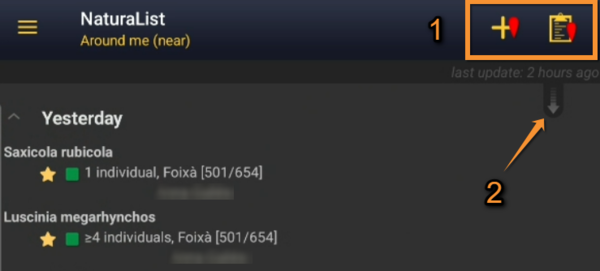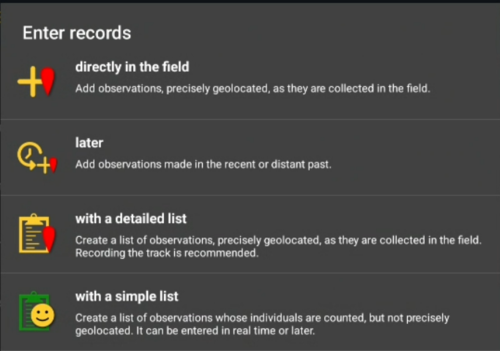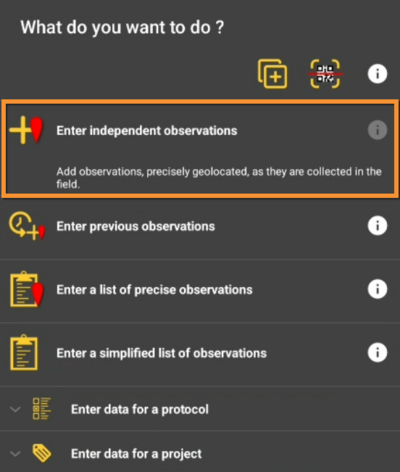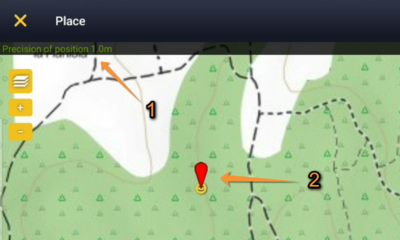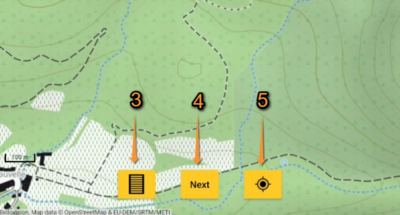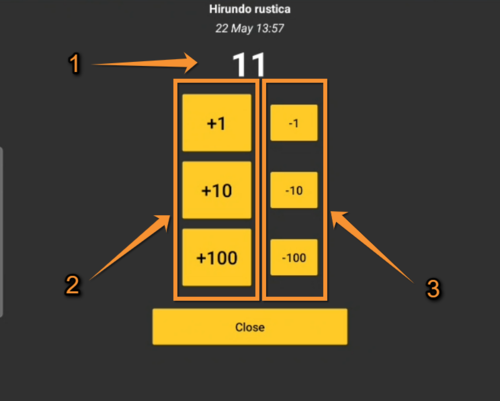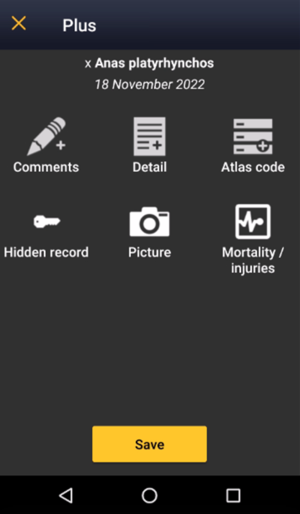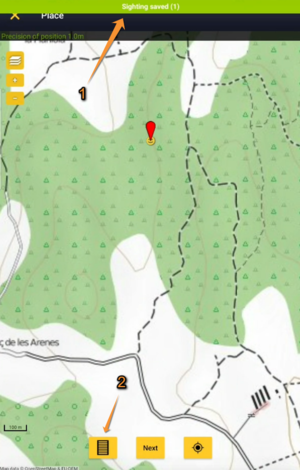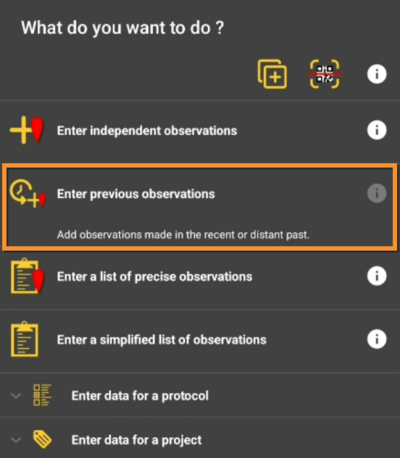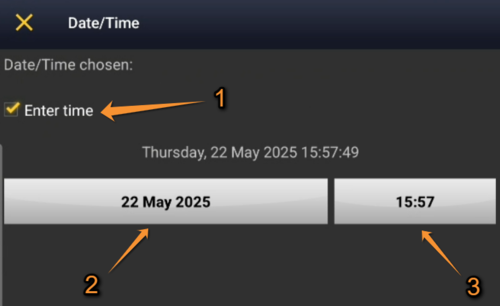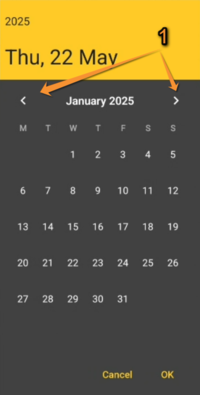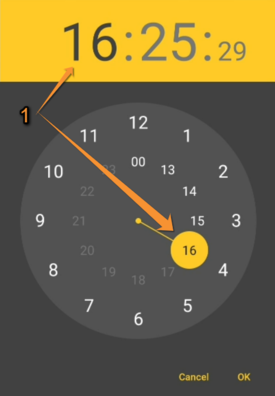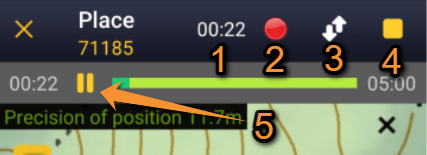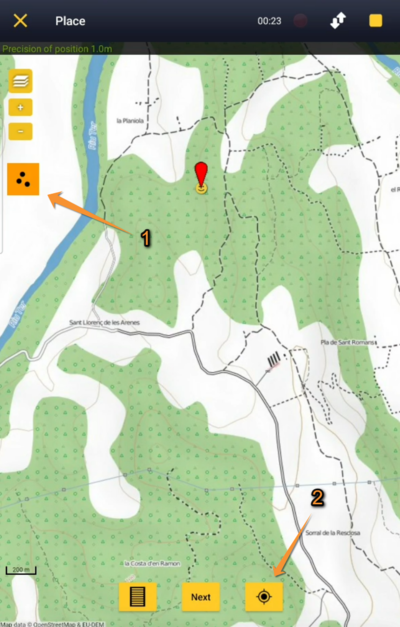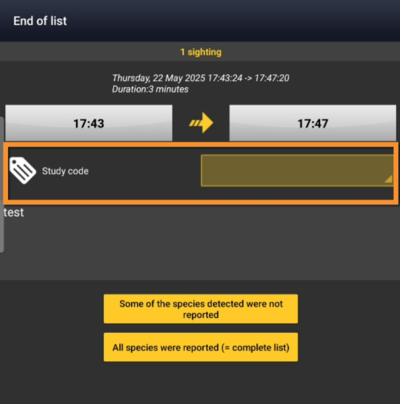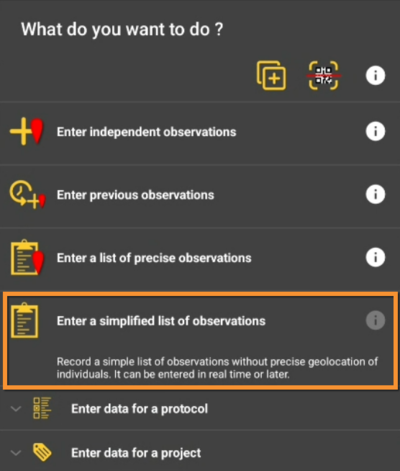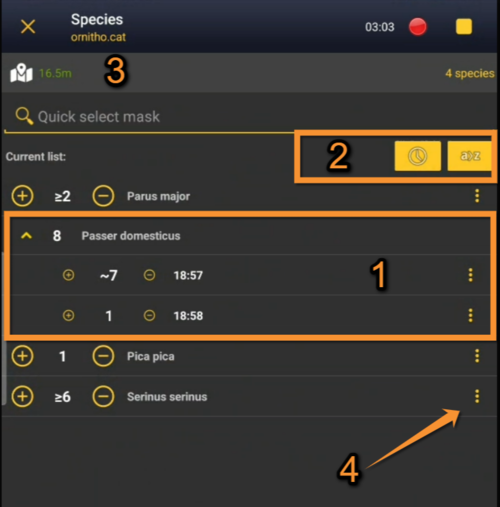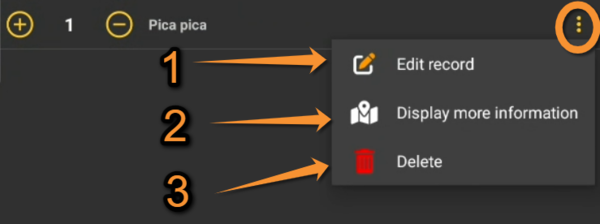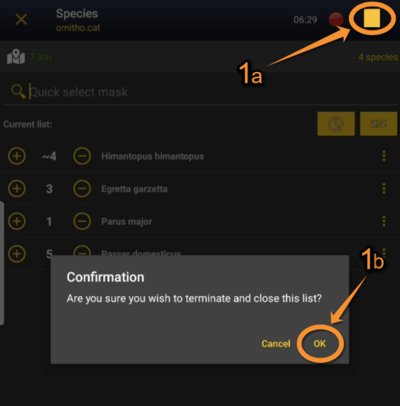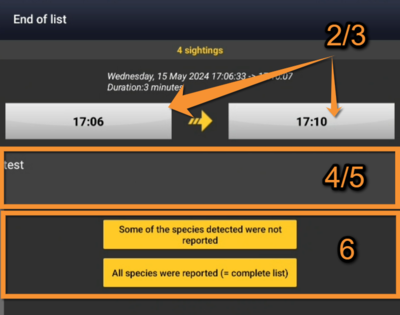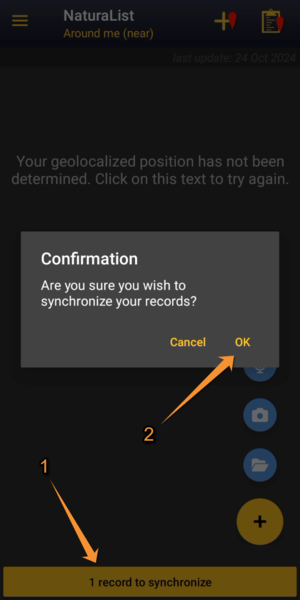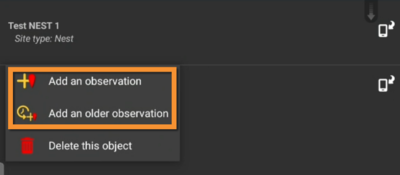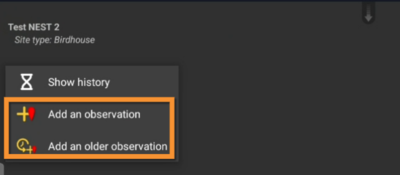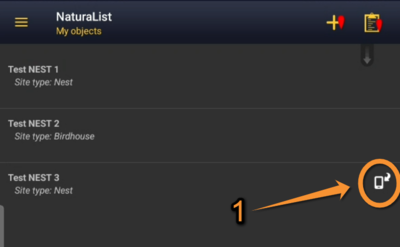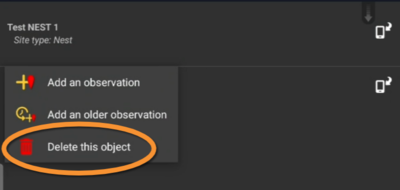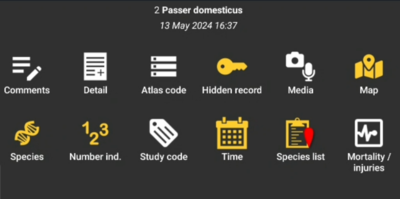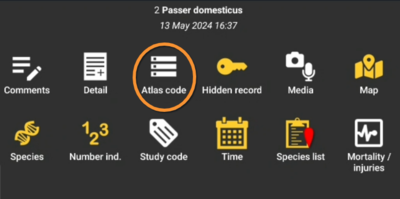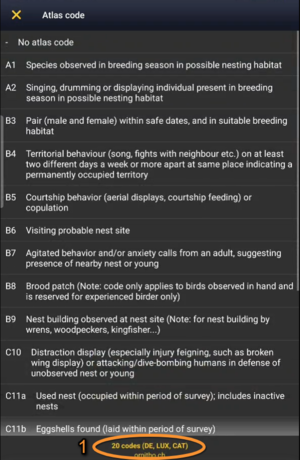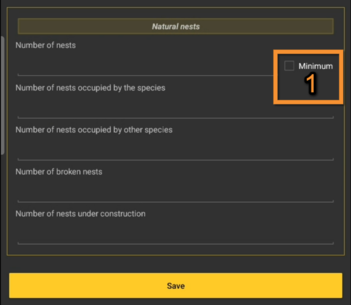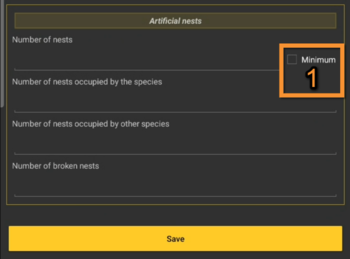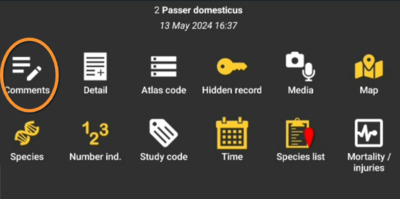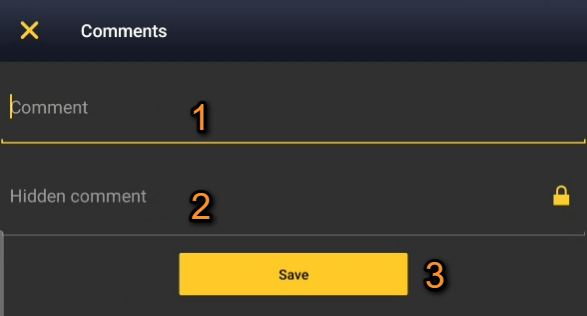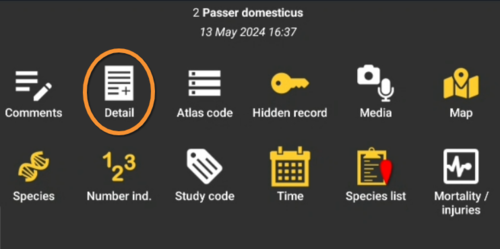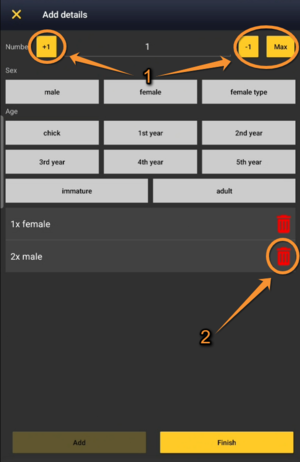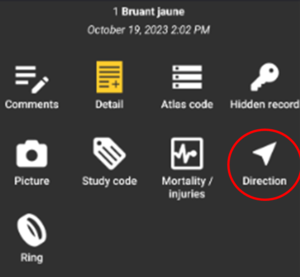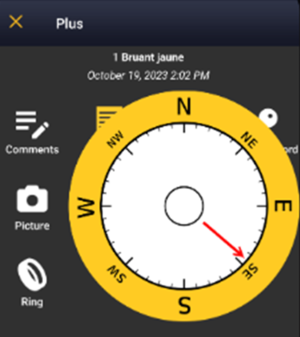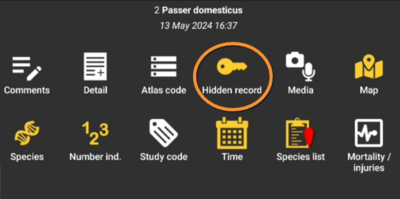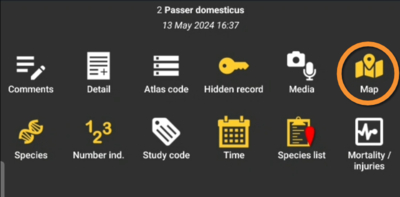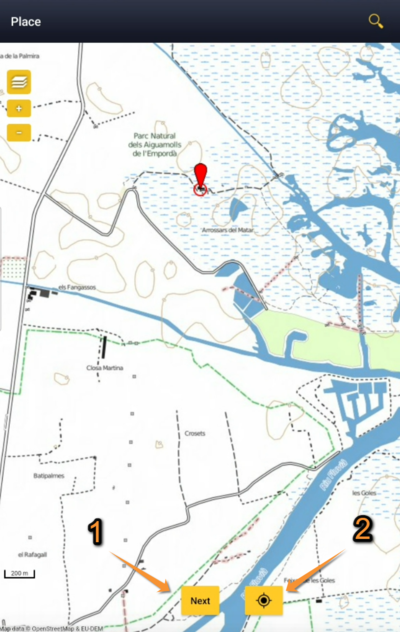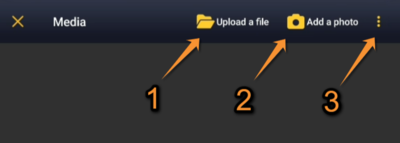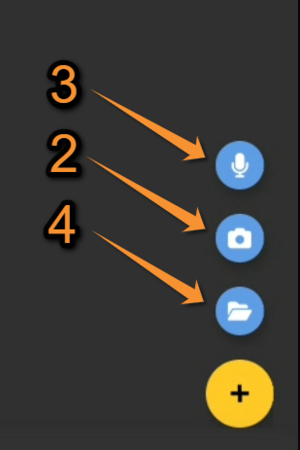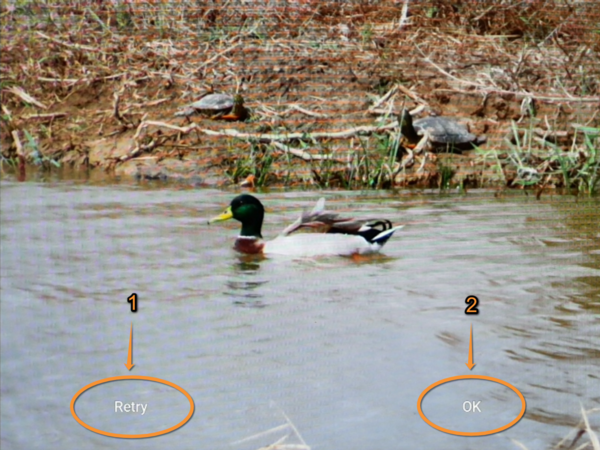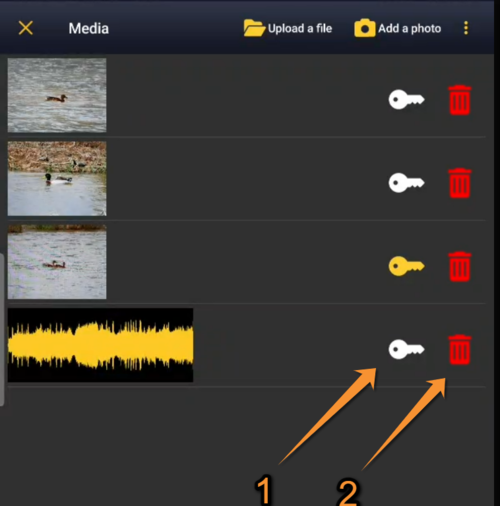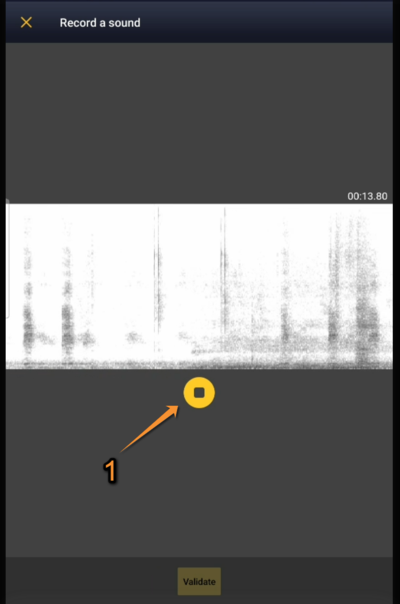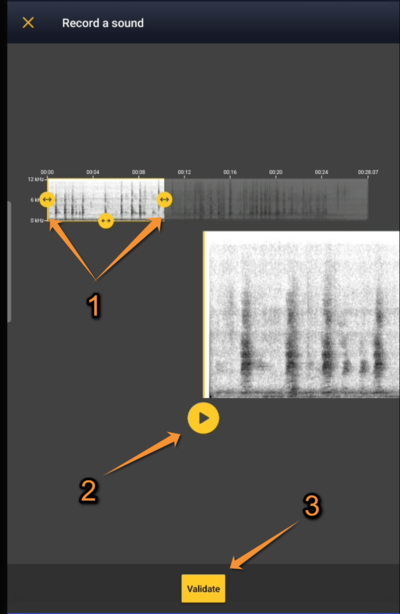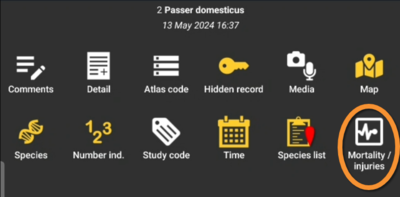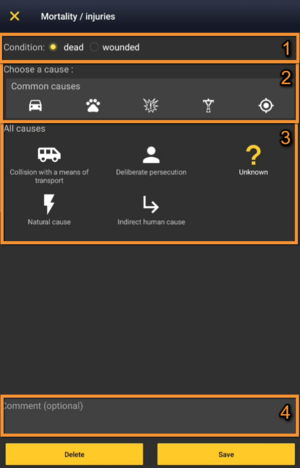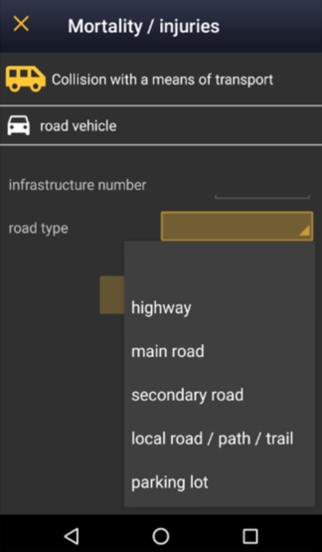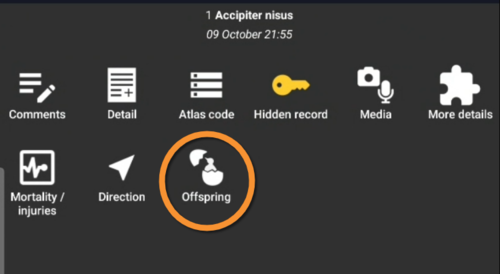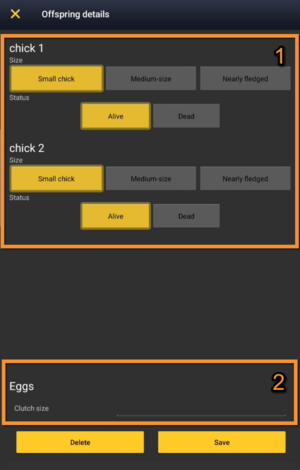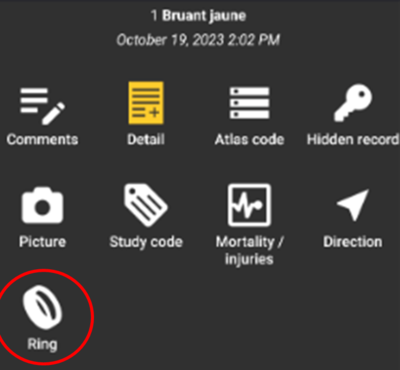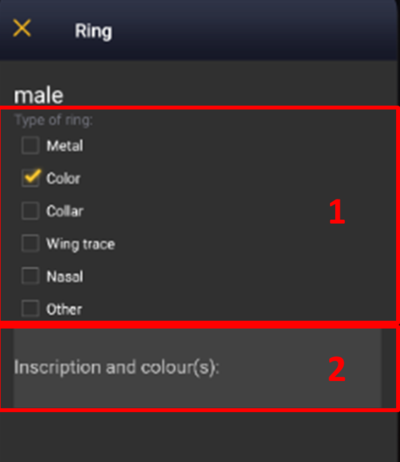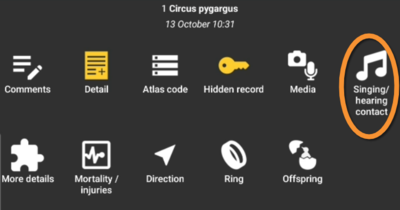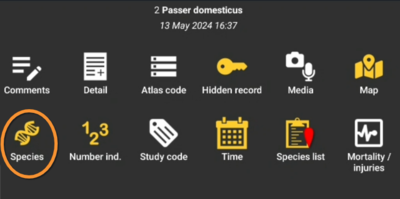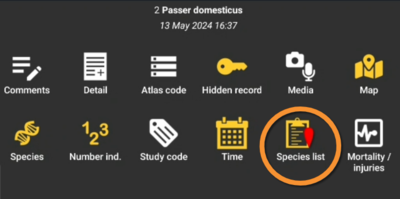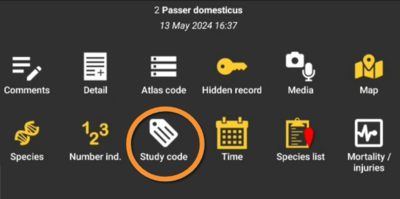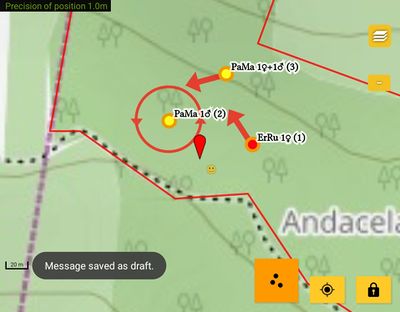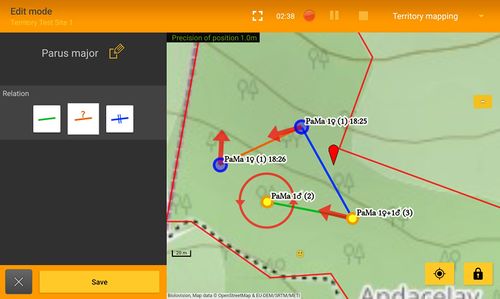Entering records
TIP FOR BEGINNERS:
If you are not yet familiarised with the application, enter records as independent observations. This is the easier option.
As you familiarise with the application, move to other options. Lists are the more useful way to enter data for conservation purposes.
Basics steps for entering data:
1:Choose the way you want to enter data > 2:choose place > 3:select species > 4:select number> 5:skip or fill in the non mandatory fields > 6:save > 7: enter next data
To enter observations,
1. choose one of the quick access keys,
2. attach a sound or image file to an observation, or
3. open the full menu to see all options associated to your account.
Contents
-
1 How to enter data
- 1.1 Quick access keys
1.2 Attach a sound or image file
1.3 Full menu
-
1.3.1 Enter independent observations
- 1.3.1.1 Step 1: Place
1.3.1.2 Step 2: Species
1.3.1.3 Step 3: Number of individuals
1.3.1.4 Step 4 (non mandatory fields): Additional information
1.3.1.5 Step 5: Ending the record
-
1.3.2 Enter previous observations
- 1.3.2.1 Step 1: Date / Time
1.3.2.2 Step 2: Place
1.3.2.3 Step 3: Species
1.3.2.4 Step 4: Number of individuals
1.3.2.5 Step 5 (non-mandatory): Additional information
1.3.2.6 Step 6 (last step): Ending the records
-
1.3.3 Enter a list of precise observations
- 1.3.3.1 Step 1: Starting a list
1.3.3.2 Step 2: Place
1.3.3.3 Step 3: Species
1.3.3.4 Step 4: Number of individuals
1.3.3.5 Step 5: Additional information
1.3.3.6 Ending the list
-
1.3.4 Enter a simplified list of observations
- 1.3.4.1 Step 1: Date / Time
1.3.4.2 Step 2: Place
1.3.4.3 Step 3: Species
1.3.4.4 Additional information
1.3.4.5 Step 4: Ending the list
How to enter data
Start entering observations by,
1. clicking one of the quick access keys,
2. attaching a sound or image file to an observation, or
3. selecting from the full menu.
If you are starting with NaturaList, we recommend you start entering independent observations within the Main menu.
1. Quick access keys
Use one of the icons on the top right corner to quickly access one of the following modules to enter data:
· ![]() Enter independent observations.
Enter independent observations.
· ![]() Enter a list of precise observations.
Enter a list of precise observations.
Quick access keys.
1. Quick access keys
| . | Enter independent observations. | |
| . | Enter a list of precise observations. |
2. Refresh: Scroll down the arrow to refresh records. It is especially useful when browsing records Around me.
To enter your observations, click on the + sign at the bottom right corner (3) (see image Submitting records). A menu will open with all possible options linked to your account (see image Different options to submit records). We will present here the basic functions, advanced tools will be described under Protocols and Projects.
2. Attach a sound or image file
Enter observations associated to an existing sound or image file. Either:
· ![]() Record a sound
Record a sound
· ![]() Take a picture
Take a picture
· ![]() Load a sound or image file.
Load a sound or image file.
When selecting a file, all compatible files open. All information associated to the file is loaded automatically, date, GPS position, and species if using Swaroski's AX Visio. You are taken directly to the Additional information panel, unless previous data needs to be entered (ie. Species).
Click on ![]() to open all options to enter records.
to open all options to enter records.
Click on ![]() to know the differences between options.
to know the differences between options.
For specific functions, open the panel first to access all protocols or projects you have access to. Use arrow Use grey arrow to open/close panel. The right will be granted to you by a local portal administrator under certain conditions.
Enter independent observations
Enter casual observations in real time.
Access it from the main menu or from the shortcut on the top right corner of the screen.
1 Enter independent observations
Step 1: Place
REMEMBER:
Smiley = Observer's position
Red marker = Data position
Indicate the position of the observed individual by moving the map to match the red marker.
To know how to navigate the map, see wiki section Mobile interface > Navigating the map. A grey smiley indicates the GPS did not detect your position. Use ![]() to activate the GPS on demand and wait for the yellow smiley before continuing. Your GPS precision is indicated on the top left of the map when the smiley is yellow. When done, click on Next.
to activate the GPS on demand and wait for the yellow smiley before continuing. Your GPS precision is indicated on the top left of the map when the smiley is yellow. When done, click on Next.
Note: You can use ![]() on the left to see a list of all your previous records (see image below).
on the left to see a list of all your previous records (see image below).
Step 2: Species
According to the parameters selected in preferences, there are different possibilities to enter the species name:
· Choose by search: Choose the taxonomic group from the top horizontal panel and start typing the species name. A list will appear underneath from which to choose the correct species. See image Display of species by species, or wiki section Mobile interface > Getting started > Personalisation > Display of species.
· Choose by group, family, species: Start by selecting the taxonomic group, then the family and finally the species. See image Display of species by group, family, species, or wiki section Mobile interface > Getting started > Personalisation > Display of species.
· Shortcuts: Use the shortcuts on top (see image Shortcuts) to enter the species faster, or create new shortcuts if needed. Visit wiki section Mobile interface > Shortcuts to know more about shortcuts and how to create them.
Note: you can modify your preferences by going to Menu > Preferences > Personalisation > Display of species (see image Display of species).
Step 3: Number of individuals
Enter the number of individuals first and choose the accuracy of the count.
Choose between:
Not counted (an x will appear) no need to enter a number
1: approximate number of individuals
2: exact number of individuals
3: equal or minimum number of individuals
(see image below).
If you did not see any individual and you want to signal it, enter exact number 0 (0 and click =).
Entering number of individuals.
1. Approximate number
2. Exact number
3. Minimum number
4. Start a counter
Enter FIRST the number of individuals and then the count precision. Once you enter the count precision, you are taken to the next screen and will have to use the back button to modify.
To add new individuals as you count them, click on Start a counter and keep adding or subtracting individuals (see image below) until all are counted or you need to move to another species. Click Close to end the count and continue entering the observation.
Start a counter can be very useful when counting flocks.
Step 4 (non mandatory fields): Additional information
Add more information or modify existing one on this record.
Click on any icon to enter (or modify) information in the selected icon, and click Save when done to continue entering records.
If you do not need to add or amend information, click Save directly to skip this section.
NOTE
YELLOW ICON = the module contains information about the record.
WHITE ICON = the module does not contain information about the icon.
Sections available depend on the type of list, or protocol, and on the country. Visit wiki section Mobile interface > Submitting records > Additional information panel for full details on all available modules.
Step 5 (last step): Ending the record
To end entering an observation, click Save.
A green line on top will appear for some seconds to indicate the data is saved. You will be taken to Step 1: Place to enter new records.
To access the list of data already entered, click on ![]() . Click on any of the records to see details and/or edit (see Editing records).
. Click on any of the records to see details and/or edit (see Editing records).
Enter previous observations
Enter casual observations after they occur.
COMPARISON BETWEEN "INDEPENDENT OBSERVATIONS" AND "PREVIOUS OBSERVATIONS"
Entering independent observations is faster as date and time are already selected for you. Selecting a location is also faster if using the aim icon: you are already correctly positioned!
Entering previous observations is useful when observations are noted on another support, such as a paper notebook, on rainy days, when the phone’s battery is low, or for any other reason you prefer not to use your device in the field.
2 Enter previous observations
Step 1: Date / Time
· Entering a date is compulsory.
· Entering time is not. Check the corresponding box to open the option to enter time (image Entering date and time).
Since observations may be entered after they occurred, entering a time is optional.
·
Check Enter time to enter the time or leave it unchecked if you do not want to enter a time. Click on the date button to modify date, and on time button to modify time.
·
When date and time (optional) are correct, click Save to move to next step.
Enter date:
Click on the default (current) date button to open a clickable calendar and choose the appropriate day. Use arrows to change month.
Click OK when done to close the calendar.
Enter time:
· Tick Enter time.
· Click on the default (current) time to open a clickable clock.
· Select first the hour, then the minutes, and finally the seconds. Or click on the corresponding part of the digital clock on top to indicate if you are adjusting hour, minutes or seconds. The parameter you are adjusting shows in bold in the digital clock (see image below). Exact seconds may be important for some taxa, for protocols, or in lists.
· Click OK to save and continue.
Step 2: Place
Place the red marker on the location where the observation took place (as described in wiki section Mobile interface > Submitting records > Enter independent observations > Step 1: Place).
Yellow smiley and red marker may not match in this case as the observation is entered a posteriori.
To learn how to navigate the map, see wiki section Mobile interface > Navigating the map.
Step 3: Species
Enter species as described in wiki section Mobile interface > Submitting records > Enter independent observations > Step 2: Species.
Step 4: Number of individuals
Enter the number of individuals as described in wiki section Mobile interface > Submitting records > Enter independent observations > Step 3: Number of individuals. Note in this option one cannot Start a count as in other options.
Step 5 (non mandatory): Additional information
Enter any other additional information as described in wiki section Mobile interface > Submitting records > Enter independent observations Step 4: Additional information.
Step 6 (last step): Ending the record
When you finish entering an observation, click Save and you will be taken to Step 1: Date/Time to allow you to enter other data later. A green line shows on top to prove data is saved, then automatically disappears.
Enter a list of precise observations
Select this option to create a list in the field in real time. You can access it from the menu or from the quick key at the top right corner of the screen.
3 Enter a list of precise observations
Step 1: Starting a list
The 3 options below are optional. To go directly to the list, click Next.
- 1. Enter a comment about this list if appropriate. You can still comment individually every record.
- 2. Select Record the trace if you want to record your track. The default option is set in Main menu > Preferences > Personalization > Keeping the trace. Visit wiki section Mobile interface > Getting started > Preferences > Personalization > Keeping the trace to know more.
- 3. Select Hide all records from the public if you want it to be the default option while creating this list. You can change it later for individual observations you want to share anyway. Administrators will still have access to your records once submitted. Note: If in Preferences you chose to hide records, all your records, including lists are hidden automatically.
- 4. Click Next to start entering your data.
Starting a list of precise location.
1. Type a comment if necessary.
2. Check to Record the track.
3. Check to Hide your records from the public.
When you click Next
· an intermittent red dot will appear at the top of your screen indicating the list is running.
· All records you enter are considered to be part of this list.
· The taxonomic group of the first record you enter will determine the taxonomic group of the list. If you enter a new taxonomic group, you will be warned and it will still be recorded though not as part of the list.
· You can see for how long the list is running along with the red dot.
· Use the keys on the right of the screen to pause or stop the list (see image below). Pause the list to enter other records alongside it, either from the same or different taxa.
BREAK: Enter other species from the same or different taxa but do not include them on the ongoing list. The time continues running.
STOP: End the list. The time will stop running.
Step 2: Place
· Place red marker at the observation's position by moving the map. See Mobile interface > Navigating the map to know more about the map.
· Click ![]() , to automatically place the marker at your GPS location and center it.
, to automatically place the marker at your GPS location and center it.
· "A list of precise observations" requires you to indicate the exact position of the observation. Therefore, using ![]() is useful to know where you are and for observations that are on your same spot, for example plants or some insects.
is useful to know where you are and for observations that are on your same spot, for example plants or some insects.
Click Next when done.
Note: ![]() shows/hides other records on the list. It is possible to select a record to modify or delete it.
shows/hides other records on the list. It is possible to select a record to modify or delete it.
Step 3: Species
Enter species as described in wiki section Mobile interface > Submitting records > Enter independent observations > Step 2: Species.
Step 4: Number of individuals
Enter number of individuals as described in wiki section Mobile interface > Submitting records > Enter independent observations > Number of individuals.
Step 5: Additional information
Enter any other additional information as described in wiki section Mobile interface > Submitting records > Enter independent observations > Step 4 (non mandatory fields): Additional information.
Ending the list
Click the stop button on top to end the list and confirm (see image).
Ending list in the field.
1. Stop recording. See difference between break and stop for more information.
2. Confirm ending the list.
· Adjust starting time and ending time if necessary, for example if you forgot to stop the list when you finished recording (see image below). Otherwise, starting and ending time will be automatically detected.
· Add any comment if necessary, and
· indicate if is a
- · partial list (not all species detected were recorded) or
- · complete list (all species seen or heard were recorded). A complete list does not refer to species present but to species detected.
If you are granted the necessary rights, you may be asked if your list belongs to a project or a protocol. If this is the case, select the project or protocol code from the expandable menu.
When displaying data, observations belonging to a partial list are represented with a hollow green square, and those belonging to a complete list are indicate by a full green square. See wiki section Various > Symbols cheatsheet for more information.
Enter a simplified list of observations
Allows creating simplified lists in real time or that took place in the past.
· May not enter a precise location for each record, but enter records
- · at your position (real time) or
- · at one point (observation entered in the past).
- · at your position (real time) or
· the record gets a new precision marker called “unprecise”.
4 Enter a simplified list of observations
-
4.1 Step 1: Date / Time
4.2 Step 2: Place
4.3 Step 3: Species
4.4 Additional information
4.5 Step 4: Ending the list
Step 1: Date / Time
By default the app shows the current date and time, which can be used as such to record a real time list.
If your observations happened in the past,
· click on the date to modify it by selecting from the expandable calendar
· click on the time to select the starting time of the list and select from the expandable clock as in Mobile interface > Submitting records > Enter previous observations > Step 1: Date / Time.
Add a comment if necessary and indicate if you want to hide the records from the public and/or record your trace. Administrators will still see them once they are synchronised.
Visit wiki section Mobile interface > Getting started > Preferences > Personalization > Keeping the trace to know more about recording your trace.
When done, click Next.
NOTE
If you change the time within 5 minutes of the given time, or do not change it at all, your list is considered a real time list and you have the option to record the trace. You will not be able to indicate the position of your observation, and it will be automatically considered to be the same as the position of your GPS.
If you change the time more than 5 minutes of the real time, your list is not considered a real time list and the option to record the trace gets unresponsive. You will be able to select the position of your observations on a map, as explained in next sub section Place.
Step 2: Place
Option only available if you are entering a list after it occurred. That is, if you changed the time in the previous screen more than 5 minutes from the real one.
Select the position as in Mobile interface > Submitting records > Enter previous observations > Step 1: Date / Time.
Click Next when done.
NOTE:
- For a list entered later than it occurred the location will be the same for all the sightings, so the first time you select a place will be the position for all the following data you insert.
- If you are covering a big area or different ecosystems, consider doing so in separate lists.
Step 3: Species
Enter species as described in wiki section Mobile interface > Submitting records > Enter independent observations > Species.
For a real time list, it is now possible to enter the same species several times separately. All records are kept with their time and location (see image below).
Entering species Enter a simplified list of observations.
1. Species list: Repeated species are saved separately.
2. Sort list: Click on the clock (left) to sort the list chronologically, or on the letters (right) to do so alphabetically.
3. Location and number of species: GPS precision (left) and the number of species already entered (right). Click on the map to see your location.
4. Additional information: Click the dots to open the additional information panel.
For a real or delayed list, you can also use symbols + and - to enter number of individuals (see image below). The location is the same for all individuals.
Additional information
You will not be prompted to enter additional information. However, you can add it after entering a record in the list or after finishing the list (see Editing records for more information).
While creating the list, click on a species name and select Edit record to access the additional information menu.
See wiki section Mobile interface > Submitting records > Additional information panel to navigate all sections in the menu.
If only the number of individuals needs to be modified, use the plus and minus signs on the left of the species name to modify the count (see image below). The new number is saved automatically.
Click on the species name and select Delete to delete the record.
If your list occurs in real time, the screen will also show GPS precision (on the top left corner, in green or red) and the number of species already entered (top right corner, see image below).
If besides, you are in Africa, it will indicate in the middle the atlas grid number of the African atlas.
Step 4: Ending the list
When all records are entered,
1. click on the "stop" icon at the top right corner to finish the list, and confirm.
BREAK: Temporarily stop the timer to, for example, enter additional observations. Re-start the list by clicking on the white badge.
STOP: Stop the timer and close the list.
2. Click on the time button to open an expandable clock and introduce ending time if necessary as explained in wiki section Mobile interface > Submitting records > Enter a list of precise observations > Ending the list.
3. Adjust starting time if necessary.
4. Enter/ Modify a comment if necessary.
5. Enter any other required information. It may vary from country to country.
6. Finally, indicate if you recorded all species present or only part of them (see image).
COMPARISON BETWEEN "A LIST OF PRECISE OBSERVATIONS" AND "A SIMPLIFIED LIST OF OBSERVATIONS"
A list of precise observations preselects date and time for you but requires you to enter the position for each record. If the position of the observation is your current position, use ![]() to be faster. It also allows entering additional information for each record within each entry.
to be faster. It also allows entering additional information for each record within each entry.
A simplified list of observations can also be used in the field. In this case, you need to select date as well as starting and ending time. However, you will not be prompted to enter the position for each observation and the additional information menu will not be automatically displayed for each record. This saves time and reduces the chances of missing some individuals.
Use "a simplified list of observations" also in the field in real time if you do not need to get exact positions for each individual or add detailed information (as age, sex, pictures or atlas codes) for most of them.
[Top to Enter a simplified list of observations]
[Back to Submitting records]
Synchronisation
Once records are entered and modified if necessary, synchronize them.
When synchronising:
· records become public*,
· validators can verify records,
· administrators can use records for planning conservation.
*If records were hidden from the public, they will not be visible to other users, but administrators will still see them, verify them and use them for conservation purposes.
To synchronise,
· click on the reminder at the bottom of the screen
· and confirm (see image below).
Once your records are synchronised, you can no longer modify them in NaturaList, but you can do so from your local portal.
See a list of local portals in the wiki section Various > Local portals and partners.
Go to wiki section Web interface > Editing records for more information on how to edit records on the web site.
If no local portal exists for the site (for example in Africa or outside Europe), go to https:data.biolovision.net to make changes.
Why to synchronise:
- Share your observations with fellow naturalists.
- Participate in conservation initiatives.
- Back up your records online (otherwise you may lose them if your phone crashes).
- Confirm dubious records.
Create an object
Record a nest, a burrow, a birdhouse, or similar object encountered on the field, and attach it to an observation.
This function is only available to users with special rights.
For detailed information, visit the wiki section Mobile interface > Create an object.
Create an object
Access it as if entering data, and click Create object (see image below).
Visit wiki section Mobile interface > Create an object > Create object to know how to create an object.
Attach objects to observations
Objects can be associated to observations either before or after synchronisation.
Visit wiki section Mobile interface > Create an object > Attach objects to observations to know how to associate an object to an observation, for example, a nest.
Browse created objects
Objects can be seen in NaturaList and on the local portal.
Visit wiki section Mobile interface > Create an object > Browse objects to see your created objects.
Edit objects
Visit wiki section Mobile interface > Create an object > Edit objects to modify your objects.
Delete objects
Delete your objects directly from NaturaList.
Visit wiki section Mobile interface > Create an object > Delete objects to delete your objects.
[Top to Create an object]
[Back to Entering records]
Additional information panel
Modules allowing to enter additional information to the recorded observation.
Depending on the list or the protocol used, the additional information panel (see image below) may be opened automatically while entering observations (ie. Enter independent observations) or may require the user to access it as if editing the record (ie. Enter a simplified list of observations).
Not all modules are available in all countries and lists/protocols.
Expand the table below to see all available modules in the Additional information panel.
Yellow icons indicate the module has some information in it (ie. Time or Map in the list below), while white icons indicate the module does not contain any information yet.
| Additional information modules | ||||||||||
|---|---|---|---|---|---|---|---|---|---|---|
| Icon | Description | |||||||||
| Atlas code Add a code to indicate breeding stage. |
||||||||||
|
|
Colony Add information about a colony if the individual observed is a colony breeder. |
|||||||||
| Comments Add a comment about the observation, and hide or show it to the public. |
||||||||||
| Detail Indicate the age and sex of individuals observed. |
||||||||||
| Direction Indicate flight direction of individuals recorded. |
||||||||||
| Extra protocol Add information about nests. |
||||||||||
| Hidden record Choose to hide or show your observation to the public. It is independent from the comment: you can hide the comment and still show the observation. |
||||||||||
| Map See the observation's location. |
||||||||||
| Media Attach an image or a sound to your record. |
||||||||||
| More details Indicate nesting habitat and additional information such as behaviour, migration and individual's health. |
||||||||||
| Mortality Add information about injuries or deaths. |
||||||||||
| Number of individuals Enter or modify the number of individuals and the count precision |
||||||||||
| Offspring Enter the number of eggs in the nest |
||||||||||
| Protocol |
||||||||||
| Ring Enter ring details if the individual/s of your observation is/are ringed. |
||||||||||
| Singing/Hearing contact |Click to indicate if you heard vocalisations. Yellow icons indicates there were, white icons indicate there were not. |
||||||||||
| Species Change species name. |
||||||||||
| Species list Change general information about the list the record belongs to. Click on the clock to change starting and/or ending time, enter/modify the comment, and/or check All species were recorded if all species were recorded. |
||||||||||
| Study code Select study code if your observation belong to any of the listed studies. |
||||||||||
| Time Change time by clicking on the given time. Check Do not enter to hide record's time. |
||||||||||
|
|
||||||||||
1.4 Additional information
- 1 Atlas code
2 Colony
3 Comments
4 Details (Age and Sex)
5 Direction
6 Extra protocol
7 Hidden record
8 Map
9 Media
10 More details
11 Mortality / injuries
12 Number of individuals
13 Offspring
14 Protocol
15 Ring
16 Singing/Hearing contact
17 Species
18 Species list
19 Study code
20 Time
Additional information on mapping protocols
Atlas code
Select an atlas code, or no code.
Available atlas codes will depend on the country you chose in Preferences.
For information the coding system used is indicated at the bottom of the screen (see image below).
During the breeding season some countries may ask automatically to enter an atlas code. It is highly encouraged you do so (very useful, for example, for breeding atlas) but it is not compulsory.
Go to Menu > Preferences > Atlas code to change the code you use.
[Top to Atlas code]
[Top to Additional information panel]
Colony
Enter information about the breeding colony. <br/.
The Colony module may open on the additional information panel if:
· a colony breeding individual is recorded,
· the observation occurs during breeding season, and
· an atlas code indicating breeding has been selected for this sighting.
1. Enter number of pairs observed.
Modify number of individuals if necessary (see image below).
2. Enter nest information according to nest nature (see image below):
· Natural nests
· Artificial nests
[Top to Colony]
[Back to Additional information panel]
Comments
Leave a comment, if necessary.
It can be public or private:
· Use the top section to make it public and associated to your record. Any registered user will see it.
· Use the lower section if you want to keep your comment private. Note administrators will still see it.
To learn more about administrators, go to wiki section Local portals > Administration.
Click Save when done.
Validate only validates the comments.
To validate your record you will have to Save later.
[Top to Comments]
[Back to Additional information panel]
Detail (Age and sex)
Enter number of individuals per sex and age class.
According to the taxonomic group you are entering, fields for details differ, see image below.
For birds:
· Type number or use +1 -1 quick keys to quickly change the number.
- Key Max will count all individuals entered for this species.
- Key Max will count all individuals entered for this species.
· Select age and sex for each class.
- As data is entered, a list will appear at the bottom.
· Scroll up and down from the right hand bar to see all entries.
· Select ![]() to delete any entry if necessary (see image below).
to delete any entry if necessary (see image below).
When done, click Add to enter a new class or finish to end.
[Top to Details]
[Back to Additional information panel]
Direction
Click on the compass to indicate flight direction.
In the example below, the user clicked on SE.
[Top to Direction]
[Back to Additional information panel]
Extra protocol
Introduce required information about nests (see image below as an example).
This section will only appear if you are entering data into a protocol that requieres nest information. Information required may vary depending on the protocol, and may include:
- Intact nests: Type number of intact nests.
- Nest location: Click on the yellow band to see options (see image Nest location) and choose the most appropriate.
- Number of nests occupied by other species: Type number of nests occupied by other species.
- Occupied nests: Type number of occupied nests.
- Potencial breeding pairs: Type number of pairs that may be breeding.
- Suspected nests: Type number of suspected nests.
Remember fields marked with an asterisk are mandatory.
[Top to Extra protocol]
[Back to Additional information panel]
Hidden record
Select/unselect as needed.
Remember:
· A yellow key indicates the record will be hidden to other users, except administrators.
· Default option depends on your ‘’’Preferences’’’. Go to Menu > Preferences > Hide record to change it.
· Note some records are automatically hidden depending on the country or region your observation takes place in. Observations in countries not covered by any local partner are never automatically hidden. However, any user can hide records if they consider doing so will help protect the individuals, species or habitat.
To see which records will automatically be hidden locally, go to Web interface > Local portals > Species partially hidden.
To learn more about administrators, go to Web interface > Local portals > Administration.
[Top to Hidden record]
[Back to Additional information panel]
Map
Click to see your observation's position.
Click
· Next to Continue, or
· "aim icon" to see your position (see image below).
Visit wiki section Mobile Interface > Navigating the map to interpret the map if necessary.
[Top to Map]
[Back to Additional information panel]
Media
REMEMBER
Adding images already on your phone directly from the gallery will automatically upload some basic information:
- Date
- Time
- Position
- Date
- Time
- Species
- Number
- Position
Attach an image or a sound to your observation, either before or after entering a sighting, from:
· the Additional information panel, or
· the main screen.
To use the Additional information menu, enter the observation first, and
1. choose Media on the additional information panel (see image below)
It displays all images already attached to this record (see image as an example).
2. choose between
· Upload a file, if you have already taken them and they are stored on your phone's gallery. Pictures must be taken with your phone or inserted afterwards through a local portal. If no local portal exist, it is not currently possible to add a picture through data.biolovision.net.
· Add a photo then. If you do, do not forget to accept to upload it.
· Record a sound at the moment.
To use quick access keys,
· take the picture or record the sound before entering the observation, or
· select an file to upload a sound or an image file.
- Upload a file
- Upload a file
Direct access to the gallery in your phone. Choose the image or sound to attach to the observation the same way you would select any other file to attach to any platform (e-mail, whatsapp...). Some considerations must be taken into account:
· The date of the observation must match the date the file was created, if you are attaching a file to the observation you are recording. Some internal adjustments correct for differences in time zone.
· If you are attaching an observation to an already existing fiel, all information from the file (date, time...) will be automatically recorded onto the observation.
· Pictures are automatically resized to 3072 pixels on the longest side before being uploaded.
· Sound files must be maximum 16 MB to upload.
· Use the share function (instead of open) to upload more than one file at once. File information (date, time, GPS position...) of the first one will be considered the observation's information.
NOTE:
· The date of the observation must match the date the file was created.
· Pictures will be automatically resized to a maximum size of 3072 pixels before being sent.
· Sound files should be maximum 16 MB to upload.
It is also possible to attach a file by
· Open the phone's gallery,
· click on Open with, or Share and
· select NaturaList.
- Add a photo
- Add a photo
Direct access to the camera in your device. Take a picture normally and select:
· Retry to repeat it, or
· OK to upload.
See the images as they are attached.
Hide/show the picture only, not the data, to other users by clicking on the corresponding key or delete by clicking on the bin (see image below).
You will be able to edit it at a later stage.
When done, add another picture or close "Media" to access other sections or entering the observation.
- Use the key icon to hide the image while keeping the record visible.
- If you hide the record, the image is automatically hidden.
- Record a sound
- Record a sound
Press the microphone icon to start recording the sound. It will start recording immediately and the waveform is shown in real time.
Press stop to stop recording, and:
· Crop the waveform, if necessary, after stooping the recording (it is only possible to crop the time axis), or
· Validate to access other sections or to enter the observation.
It is not currently possible to playback.
[Top to Media]
[Back to Additional information panel]
More details
Indicate nesting habitat and additional information such as behaviour, migration and individual's health (see image as an example).
Open the expandable menu and indicate the most appropriate option to each field, if necessary.
[More details]
[Back to Additional information panel]
Mortality / injuries
Indicate if your observation corresponds to an injured or dead individual, and select the cause if known.
Scroll down All causes to see all options (see image Cause of injury).
Click on the category to open a panel with all possible causes and enter details (see bottom image Selecting cause of injury).
When done, click Validate.
For quick selection, the icons of the most common causes are on top (see image Cause of injury).
When done, click Save or.
Delete if necessary.
The entry can be modified later.
[Top to Mortality / injuries]
[Back to Additional information panel]
Number of individuals
Modify number of individuals recorded in the present entry.
Visit wiki section Mobile interface > Submitting records > Enter independent observations > Number of individuals for more information.
Entering number of individuals.
1. Approximate number
2. Exact number
3. Minimum number
4. Start a counter
[Top to Number of individuals]
[Back to Additional information panel]
Offspring
1. Indicate size and status of each of the chicks on the nest,
2. Type number of eggs on the nest, and
3. Choose,
- Save to save information, or
- Delete delete offspring information.
[Top to Offspring]
[Back to Additional information panel]
Protocol
[Top to Protocol]
[Back to Additional information panel]
Ring
- 1. Select the type of marking by checking the corresponding cell, and
- 2. type the inscription on the ring.
- 3. Select
- Save to save information, or
- Delete to delete ring.
- Save to save information, or
[Top to Ring]
[Back to Additional information panel]
Singing/Hearing contact
Select/unselect as needed.
A yellow singing symbol indicates there was some vocalisations, while a white symbol indicates no vocalisations.
[Top to Singing]
[Back to Additional information panel]
Species
Modify species name.
Visit wiki section Mobile interface > Submitting records > Enter independent observations > Species for more information.
[Top to Species]
[Back to Additional information panel]
Species list
Modify list parameters like time, comments or type of list.
Visit wiki section Mobile interface > Submitting records > Enter a simplified list of observations > Ending the list for more information.
[Top to Species list]
[Back to Additional information panel]
Study code
Choose from the expandable menu the project you are collecting data to, if any. Leave blank if your data does not belong to any project.
[Top to Study code]
[Back to Additional information panel]
Time
Modify ending time, if necessary.
Visit wiki section Mobile interface > Submitting records > Enter previous observations > Date and time to see how to modify a given time.
[Top to Time]
[Back to Additional information panel]
Entering additional information on mapping protocols
Some protocols may give you the option to enter additional information with icons when entering species and number of species (see image below).
Icons on white background represent different categories in atlas codes. These categories may have different code numbers in each country.
Icons on blue background represent different modules.
White background icons = Atlas codes
Blue background icons = Any other additional information fields
Atlas codes
| Singing, drumming or displaying male present in breeding season in possible nesting habitat. | |
| Unidentified individual in breeding season in possible nesting habitat. | |
| Male in breeding season in possible nesting habitat. | |
| Female in breeding season in possible nesting habitat. | |
| Pair observed in suitable nesting habitat in breeding season. | |
| Agitated behaviour or anxiety calls from adults, indicating a nest or young nearby. | |
| Recently fledged young (nidicolous species) or downy young (nidifugous species) observed. | |
| Nest-building or excavating of nest-hole observed. | |
| Adult carrying faecal sac or food. | |
| Nest containing eggs or young. | |
| No atlas code. |
Flight direction
| Flying direction. Press, hold and drag to indicate flying direction. If the individual is moving around without a clear direction, press icon but do not indicate flight direction. It will be represented with concentric circles (ie. single male in image below).This information can be combined with others in the list (see example below), but should be introduced first. |
Relationship between individuals
When two similar individuals are recorded nearby (ie. two singing males of the same species), click on both records to open relationship options (see image below).
| Both sightings correspond to the same individual. It is probably the same territory. It is reflected as a green line in the map. | |
| It is unknown if both records correspond to the same individual/s. It is reflected as an orange line in the map. | |
| Both records correspond to different individuals. It may define two different territories. It is reflected as a blue line in the map. |
Click
- Save to save and continue entering data, or
- X to close panel and continue entering data without indicating relationship.
- Save to save and continue entering data, or
To see how it will show in the web site, visit Web interface > Local portals > Protocols > Private territory mapping > Census results > Observations section.
Comments
| Comment.Type a comment, or a hidden comment in the corresponding fields and click Save. Visit wiki subsection Mobile interface > Submitting records > Enter independent observations > Additional information > Comments for more information. |
[Top to Entering additional information on mapping protocols]
[Back to Additional information panel]
